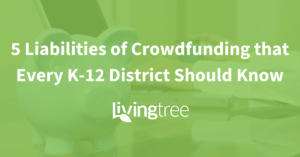In this week’s episode, Livingtree CEO Gary Hensley discusses the current situation in K-12 schools when it comes to crowdfunding and the risks that teachers, donors, and the district all face when it’s not done right.
Hi everybody, welcome to this week’s edition of two minutes with Livingtree, my name is Gary Hensley and I’m excited to talk about an important topic which is crowdfunding. It is core to our mission here at Livingtree, but I’d just like to discuss: how did we get here, what is the current situation in K-12 schools when it comes to crowdfunding?
So, a brief history on it: if you go back 10 years ago, crowdfunding was not something that you may have heard, it was a relatively new concept and so therefore you maybe had a few teachers, a few schools, that had participated in something like that. Today, you have anywhere between 20 and 30 percent of your teachers and/or schools that have an online campaign on behalf of their school or district identifying themselves as a teacher or someone related to a school. And because of that scale, districts have had to reconcile with this. Parents don’t want to sell stuff anymore, they are giving stuff online, and you have ubiquitous access to this technology. And because of that, districts are now wrestling with some of the legal, financial, and reputational consequences that come along with that.
So that is our mission here at Livingtree on our Give product to help districts manage that. But the reason for that is when you don’t do it right, you put everybody at risk. It’s one of those scenarios where it really does benefit everyone to have some safeguards in place around this topic. You are giving to a public school which is a government entity, and that money has rules and regulations about how it needs to be received. So it can put teachers at risk for receipting that money on behalf of a school, it can put the donor at risk for assuming that it is a tax deductible donation when it could not be, and it puts the district at risk with some of the district concerns: around FERPA, does it expose student images, is it for an item that might be covered by an IEP for a student so that brings in IDEA regulations, does it comply with our district standards, is it the right message that we want to put out there about what our school district is about and what we are fundraising for?
So there is a whole set of layers about this problem and the first is awareness. That’s part of why we do this is just putting things out there about how schools are funded, what parents feel about fundraising, and the last leg of the stool which is how those risks are associated with crowdfunding. It’s a very powerful tool but it’s got to be used in the right way. We’d like to get your likes and comments, have you been involved in a crowdfunding campaign, and were you aware of some of those risks and liabilities?



Pingback: How to Make Crowdfunding Work in Your School District (A Step-By-Step Guide) - Livingtree